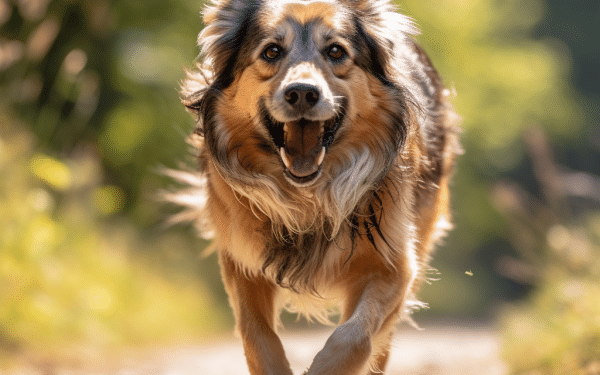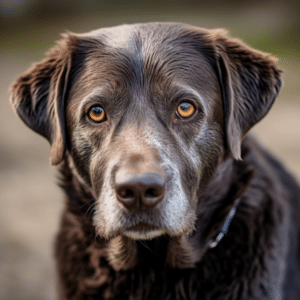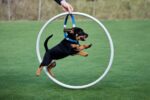Effective Training for Senior Dogs: Adapting to Aging Canine Needs

As our canine companions age, their training needs evolve. Training senior dogs requires special considerations and adaptations to ensure their continued well-being and stimulation. In this article, we will explore the challenges faced when training older dogs and offer practical solutions to help you navigate this unique phase of their lives.
Training for seniors involves understanding their changing physical and cognitive abilities and tailoring the training methods accordingly. Consistency, positive reinforcement, and patience become even more critical during this stage, as senior canines may require additional time and support to learn new behaviors.
From setting realistic expectations to addressing potty training challenges, we will cover a range of topics related to training senior dogs. We will also discuss the importance of continual training, adapting training methods to accommodate their physical needs, and incorporating mental stimulation into their routine.
Whether you are a seasoned dog owner or a first-time caregiver for a senior canine, this article is designed to provide you with valuable insights and strategies for training older dogs effectively. Let’s dive into the world of training adaptations for senior dogs and discover how you can help them lead a happy and fulfilling life.

Understanding the Aging Process in Dogs
As dogs age, their bodies undergo a series of changes that can affect their overall health and well-being. Understanding the aging process in dogs is essential for effective training, as it allows us to adapt our approaches and techniques to meet their specific needs. Here, we will explore the common physical and cognitive changes that senior dogs experience.
Physical Changes
Just like humans, senior dogs may develop arthritis, reduced mobility, and decreased muscle mass as they age. These physical changes can make it challenging for them to perform certain tasks or follow commands. It’s important to consider their limitations and adjust training sessions accordingly to prevent any discomfort or strain.
Cognitive Changes
In addition to physical changes, senior dogs can also experience cognitive decline. They may show signs of memory loss, confusion, and decreased sensory perception. These changes can affect their ability to learn new commands and retain information. Training techniques should focus on using familiar cues and commands, providing clear and consistent instructions to help them navigate through training sessions.
By understanding the aging process in dogs, we can tailor our training methods to suit their changing needs. This knowledge enables us to create a positive and supportive environment that promotes continued learning and mental stimulation for our beloved senior canine companions.
| Physical Changes | Cognitive Changes |
|---|---|
| Arthritis | Memory loss |
| Reduced mobility | Confusion |
| Decreased muscle mass | Decreased sensory perception |
Importance of Consistency in Training for Seniors
Consistency plays a crucial role in effectively training senior dogs. As they age, their ability to learn and retain information may decline, making it even more important to establish a consistent training routine. By maintaining a consistent approach, we help seniors understand what is expected of them and reinforce desired behaviors.
Establishing a regular training schedule is one way to ensure consistency. Set aside dedicated time each day to work on training exercises with your senior dog. This helps them develop a routine and know when to expect training sessions. Consistency in timing also helps reinforce their understanding of the commands and reinforces their learning process.
In addition to regular training sessions, consistency should extend to the use of verbal cues and commands. Use the same words or phrases consistently to communicate with your senior dog. This helps them associate specific commands with desired actions, making it easier for them to understand and respond. Avoid using different words or variations of commands, as this can confuse older dogs.
Creating a Consistent Environment
Consistency extends beyond the training sessions themselves. It is important to create a consistent environment for your senior dog. Keep their living space and daily routines as consistent as possible. This helps them feel secure and understand their place within the household. Consistency in feeding times, exercise routines, and sleep schedules can also have a positive impact on their overall well-being and training progress.
Remember, training is a lifelong process, and consistency is key. Even if your senior dog has mastered certain skills, continue to provide ongoing training and encouragement. This helps keep their minds engaged and their bodies active. With patience, consistency, and a tailored approach, you can successfully train your senior dog and strengthen the bond you share.
| Benefits of Consistency in Training for Seniors: |
|---|
| 1. Reinforces desired behaviors |
| 2. Helps seniors understand expectations |
| 3. Establishes a routine for learning |
| 4. Builds trust and strengthens the bond |
Positive Reinforcement: Motivating Senior Dogs
When it comes to training senior dogs, positive reinforcement is a powerful tool. This training method involves rewarding desired behaviors to motivate and encourage older dogs. Positive reinforcement not only helps build a strong bond between the dog and their owner, but it also makes the training experience enjoyable for both parties.
Using treats, praise, or play as rewards can make a significant difference in motivating senior dogs during training sessions. By associating these incentives with specific behaviors, senior dogs are more likely to repeat those actions in the future. This positive approach focuses on rewarding what the dog does right rather than punishing mistakes, which creates a positive learning environment and boosts their confidence.
“Positive reinforcement is an effective training technique for senior dogs. By rewarding them for their efforts, we can keep them motivated and engaged during training sessions.” – Dr. Sarah Thompson, Canine Behavior Specialist
It’s important to remember that the rewards used in positive reinforcement should be tailored to the individual needs and preferences of each senior dog. Some dogs may be food motivated and respond well to treats, while others may prefer praise or playtime as their reward. Understanding what motivates your senior dog is key to successful positive reinforcement training.
| Benefits of Positive Reinforcement | How to Implement Positive Reinforcement |
|---|---|
|
|
Setting Realistic Expectations for Training Seniors
When it comes to training senior dogs, it’s essential to set realistic expectations that take into account their physical limitations and individual needs. While older dogs can still learn new behaviors, they may require more patience and understanding during the training process. By adjusting our approach and being mindful of their capabilities, we can ensure a positive and successful training experience.
“Training senior dogs requires a different mindset, focusing on their strengths and adapting to their limitations,” says Dr. Sarah Anderson, a canine behavior specialist. “It’s crucial to recognize that aging can impact their cognitive abilities and physical stamina. By setting realistic expectations, we can set our senior dogs up for success and make the training process enjoyable for both them and us.”
One effective strategy for setting realistic expectations is to break down training goals into smaller, achievable steps. This allows senior dogs to progress at their own pace and helps build their confidence along the way. It’s also important to be consistent in our training methods and provide clear, positive reinforcement for desired behaviors. By focusing on what they can do and celebrating their successes, we can create a supportive and encouraging training environment.
| Realistic Expectations for Training Seniors | Training Strategies |
|---|---|
| 1. Gradual Progression | Break down training goals into smaller steps to accommodate their pace. |
| 2. Adapted Techniques | Modify training techniques to align with their physical abilities and cognitive changes. |
| 3. Patience and Consistency | Allow more time for learning and reinforce desired behaviors consistently. |
| 4. Positive Reinforcement | Use rewards, treats, and praise to motivate and reward their efforts. |
Conclusion
Training senior dogs requires us to be mindful of their individual needs and make necessary adaptations. Setting realistic expectations helps us create a positive training experience that takes into account their physical limitations and cognitive changes. By breaking down goals, using adapted techniques, and providing patience and consistency, we can help our beloved senior companions continue to learn and thrive.
Potty Training Challenges in Senior Dogs
When it comes to potty training senior dogs, pet owners often face unique challenges. As dogs age, they may experience physical changes that can affect their ability to control their bladder and bowel movements. Additionally, older dogs may develop medical conditions that further complicate the potty training process. It’s important for pet owners to understand these challenges and approach potty training senior dogs with patience, consistency, and an understanding of their individual needs.
One common challenge in potty training senior dogs is their decreased bladder control. As dogs age, their bladder muscles may weaken, leading to increased accidents indoors. It’s crucial to provide frequent opportunities for bathroom breaks and praise them for eliminating in the appropriate spot. Creating a consistent schedule for potty breaks can help senior dogs anticipate when they need to go outside. Additionally, using effective rewards and positive reinforcement can motivate their desired potty behaviors.
Training Challenges
Environmental management is another key aspect of potty training senior dogs. Senior dogs may struggle with mobility issues, making it difficult for them to reach designated potty areas in time. It’s important to ensure that these areas are easily accessible and free from obstacles. For dogs with limited mobility, using puppy pads or indoor grass patches can provide an alternative potty option. Gradually transitioning them to outdoor potty training can also be beneficial, taking into account their physical limitations.
| Common Challenges in Potty Training Senior Dogs | Strategies to Address Challenges |
|---|---|
| Decreased bladder control |
|
| Mobility issues |
|
| Cognitive changes |
|
In conclusion, potty training senior dogs requires understanding and patience. By addressing the challenges associated with decreased bladder control and mobility issues, pet owners can develop effective strategies to promote successful potty training. It’s also essential to consider any cognitive changes that senior dogs may experience and adapt training methods accordingly. With proper guidance and consistent effort, pet owners can help their senior dogs navigate the potty training process and maintain a clean and comfortable living environment.
Managing Potty Accidents in Senior Dogs
As senior dogs age, they may experience difficulties in controlling their bladder and bowels, leading to potty accidents indoors. It’s important for pet owners to understand how to effectively manage these accidents and provide a clean and comfortable environment for their furry companions. By implementing a few strategies, you can help reduce accidents and maintain a sense of cleanliness in your home.
Establish a Routine
One of the key ways to manage potty accidents in senior dogs is by establishing a consistent routine. Take your dog outside at regular intervals, especially after meals, naps, and playtime. This helps them develop a predictable bathroom schedule and reduces the likelihood of accidents indoors.
Supervise and Confinement
Another effective strategy is to supervise your senior dog closely and provide short-term confinement when necessary. Keep them in a confined area, such as a crate or a designated space with easy-to-clean flooring, when you cannot directly supervise them. This prevents accidents in other areas of your home and allows you to quickly intervene if needed.
Carpet Protection and Cleaning
If accidents happen on carpeted areas, it’s important to clean them thoroughly to prevent odors and stains. Use pet-safe enzymatic cleaners specifically designed for removing pet urine stains and odors. Consider using protective coverings, such as washable pads or waterproof mats, in areas where accidents are more likely to occur.
By implementing these strategies, you can effectively manage potty accidents in senior dogs, creating a clean and comfortable environment for both your pet and your home. Remember to be patient and provide positive reinforcement during the training process, as accidents may still occur during the learning period. With consistent effort and understanding, you can help your senior dog maintain their dignity and independence.
| Managing Potty Accidents in Senior Dogs |
|---|
| Establish a Routine |
| Supervise and Confinement |
| Carpet Protection and Cleaning |
Continual Training and Encouragement for Seniors
Training senior dogs is an ongoing process that requires continual training and encouragement. Just because a senior dog has mastered certain skills doesn’t mean that training should stop. In fact, regular training sessions can help keep their minds sharp, maintain their physical abilities, and strengthen the bond between dog and owner. Consistency, patience, and positive reinforcement are key elements in ensuring successful training for senior dogs.
Senior dogs may face physical limitations that affect their ability to learn and perform certain tasks. However, with the right training adaptations, older dogs can still engage in stimulating activities. Shorter training sessions that are tailored to their needs and abilities can be highly effective. In addition, incorporating gentle exercises, such as balance and coordination exercises, can help maintain their overall physical well-being.
Encouragement plays a vital role in training senior dogs. As they age, dogs may experience cognitive changes that can impact their motivation and learning. Providing them with positive reinforcement, such as praise, treats, or playtime, can be highly motivating and rewarding. It’s important to use cues and commands that they are familiar with to facilitate their understanding and response.
Training senior dogs requires ongoing commitment and adaptability. It’s important to understand their individual needs, abilities, and challenges, and adjust the training approach accordingly. The goal is to create an environment that promotes their mental stimulation, physical comfort, and overall well-being.
To emphasize the benefits of continual training and encouragement for senior dogs, consider the following table:
| Benefits of Continual Training and Encouragement for Seniors |
|---|
| 1. Maintains mental stimulation and cognitive abilities. |
| 2. Helps maintain physical fitness and mobility. |
| 3. Strengthens the bond between dog and owner. |
| 4. Provides a sense of accomplishment and purpose for senior dogs. |
| 5. Promotes overall well-being and happiness. |
Continual training and encouragement are essential for the overall development and happiness of senior dogs. By tailoring training methods to their individual needs and abilities, providing positive reinforcement, and maintaining consistency, we can help senior dogs lead fulfilling lives and thrive in their golden years.
Adapting Training Methods for Senior Dogs
Training senior dogs requires special considerations to accommodate their unique needs and abilities. By adapting training methods to suit their physical and cognitive limitations, we can ensure effective and enjoyable training sessions for our furry companions.
Shorter Training Sessions
One way to adapt training for senior dogs is by breaking down sessions into shorter, more manageable increments. Older dogs may tire more quickly, so keeping training sessions brief allows them to stay engaged and focused. It’s important to prioritize quality over quantity, aiming for short, productive sessions that leave dogs feeling accomplished.
Gentle Exercises and Modifications
Physical adaptations are also necessary when training senior dogs. Gentle exercises, such as low-impact activities and stretches, can help maintain joint flexibility and overall mobility. Additionally, modifications to training techniques, such as using softer or textured surfaces for agility exercises, can lessen the strain on aging joints.
Adjusting Training Techniques
Modifying training techniques to accommodate the specific needs of senior dogs is crucial. For example, using hand signals in addition to verbal cues can help compensate for any hearing loss they may experience. Likewise, incorporating more positive reinforcement, such as praise and treats, can motivate senior dogs and make the training experience more enjoyable for them.
Adapting training methods for senior dogs is essential to ensure their comfort, safety, and overall well-being. By tailoring our approach to their individual needs, we can effectively communicate with them, enhance their learning experience, and strengthen the bond between us.
Addressing Cognitive Changes in Senior Dogs
As senior dogs age, they may experience cognitive changes that can impact their ability to learn and respond to training. It is important for dog owners and trainers to understand these changes and adapt their training strategies accordingly. By addressing cognitive changes in senior dogs, we can ensure effective training and continued mental stimulation for our beloved companions.
Recognizing Cognitive Changes
Before addressing cognitive changes in senior dogs, it is crucial to recognize the signs. Common cognitive changes include memory loss, decreased problem-solving abilities, confusion, and changes in behavior. Senior dogs may also have difficulty focusing or following commands that were once familiar to them. By understanding these changes, we can approach training with patience and compassion.
Using Familiar Cues and Commands
When training senior dogs with cognitive changes, it is helpful to use familiar cues and commands that they have learned throughout their lives. By relying on their existing knowledge, we can reduce confusion and frustration. Consistency is key, as using the same cues and commands in familiar contexts will help senior dogs retain and respond to their training.
Providing Mental Stimulation
To address cognitive changes in senior dogs, it is essential to incorporate mental stimulation into their training routines. Engaging activities such as puzzle toys, interactive games, and scent work can help keep their minds active and improve cognitive function. By providing meaningful mental challenges, we can support their overall well-being and promote continued learning.
| Training Strategies for Addressing Cognitive Changes in Senior Dogs | Benefits |
|---|---|
| Using familiar cues and commands | Reduces confusion and frustration |
| Providing mental stimulation | Improves cognitive function and overall well-being |
| Adapting training techniques | Accommodates individual cognitive abilities and challenges |
By addressing cognitive changes in senior dogs through familiar cues and commands, providing mental stimulation, and adapting training techniques, we can optimize their learning potential and promote their overall cognitive health. These strategies, coupled with patience and understanding, will ensure that senior dogs continue to lead fulfilling lives and maintain strong bonds with their owners.
Incorporating Mental Stimulation in Training
Training senior dogs requires more than just physical exercise; it also involves providing mental stimulation to keep their minds sharp and engaged. Incorporating mental stimulation into their training routines can help prevent boredom, reduce anxiety, and improve overall well-being. Here are some effective ways to stimulate your senior dog’s mind during training sessions:
Variety of Puzzle Toys
Introducing puzzle toys can be a great way to challenge your senior dog mentally. These toys require problem-solving skills and provide mental stimulation through interactive play. Look for puzzle toys that are designed specifically for senior dogs, ensuring they are not too complex or physically demanding.
Interactive Games
Engaging in interactive games with your senior dog can be both entertaining and mentally stimulating. Games like hide-and-seek or treasure hunts can help them use their senses and require them to think and search for hidden objects or treats. These games strengthen the bond between you and your dog while keeping their minds active.
Scent Work
Scent work is an excellent mental exercise for senior dogs. It taps into their natural instinct to sniff and search for scents. You can create DIY scent work activities by hiding treats or toys around the house and encouraging your dog to find them using their sense of smell. This activity provides mental stimulation and can be particularly beneficial for older dogs with limited physical mobility.
| Benefits of Mental Stimulation in Training |
|---|
| Prevents boredom and destructive behaviors |
| Reduces anxiety and improves overall well-being |
| Enhances cognitive abilities and mental sharpness |
| Strengthens the bond between you and your senior dog |
By incorporating these mental stimulation techniques into your senior dog’s training, you can help keep their minds engaged, promote their overall cognitive health, and enhance their training experience. Remember to adapt the activities to their abilities and make them enjoyable for your furry friend.
Understanding and Addressing Medical Conditions
As senior dogs age, they may develop various medical conditions that can impact their overall well-being and training. It is crucial for dog owners to have a good understanding of these conditions and how to address them effectively. By working closely with a veterinarian, you can ensure that your senior dog receives the necessary medical care and support.
One common medical condition in senior dogs is arthritis, which causes joint inflammation and pain. This can make it challenging for them to move around and participate in training activities. It’s important to modify their training routine by avoiding high-impact exercises and providing them with comfortable resting areas. Additionally, your veterinarian may recommend medications or supplements to manage their pain and improve their mobility.
Medical Conditions
Another prevalent medical condition in senior dogs is cognitive dysfunction syndrome (CDS), which is similar to Alzheimer’s disease in humans. Dogs with CDS may exhibit signs of confusion, disorientation, and memory loss. Training techniques that focus on repetitive cues and commands can be beneficial for these dogs. Environmental enrichment activities, such as puzzle toys and interactive games, can also help stimulate their cognitive function.
Furthermore, senior dogs may experience sensory impairments, such as hearing loss or vision problems. It’s essential to adapt your training methods by using visual cues or hand signals for dogs with hearing loss, and avoiding dark or unfamiliar environments for dogs with vision problems. Making these adjustments can help your senior dog overcome any limitations and continue to learn and thrive.
| Common Medical Conditions in Senior Dogs | Treatment and Management |
|---|---|
| Arthritis | – Modify training routine – Provide comfortable resting areas – Medications or supplements for pain management |
| Cognitive Dysfunction Syndrome (CDS) | – Focus on repetitive cues and commands – Environmental enrichment activities – Consult veterinarian for medication options |
| Sensory Impairments (e.g., hearing loss, vision problems) | – Use visual cues or hand signals – Avoid dark or unfamiliar environments – Provide extra support and guidance |
Tailoring Training to Individual Senior Dogs
When it comes to training senior dogs, a one-size-fits-all approach simply doesn’t work. Each senior dog is unique, with their own personality, abilities, and challenges. To ensure effective training, it’s important to tailor the training approach to suit the individual needs of each senior dog.
Patience, understanding, and flexibility are key when tailoring training for senior dogs. Some older dogs may have physical limitations that require adjustments to the training techniques or the use of gentler exercises. Others may have cognitive changes that require the use of familiar cues and commands. By taking the time to understand and address these individual needs, trainers can create a training plan that maximizes the potential of each senior dog.
It’s also important to consider the unique personalities of senior dogs. Just like humans, dogs have different temperaments and learning styles. Some may be more motivated by food rewards, while others may respond better to praise or playtime. By identifying what motivates each senior dog and using positive reinforcement techniques tailored to their preferences, trainers can create a positive and engaging training experience that encourages their senior dogs to learn and thrive.
| Key Considerations for Tailoring Training to Senior Dogs |
|---|
| 1. Understand the dog’s physical limitations and adjust training techniques accordingly. |
| 2. Adapt training to accommodate any cognitive changes the dog may be experiencing. |
| 3. Identify the individual dog’s motivators and use positive reinforcement techniques tailored to their preferences. |
| 4. Consider the dog’s unique personality and learning style when designing the training plan. |
By tailoring the training approach to suit the individual senior dog, trainers can help them maintain their mental stimulation, enhance their overall well-being, and strengthen the bond between the dog and their owner.

Conclusion
In conclusion, training senior dogs requires special considerations and adaptations. By understanding the aging process in dogs and the challenges they may face, we can tailor our training methods to suit their needs. Consistency is key in reinforcing desired behaviors, and positive reinforcement serves as a powerful motivator for senior canines.
Setting realistic expectations is crucial when training seniors, taking into account their physical limitations. Potty training can be a challenge, but with patience, consistency, and proper management techniques, accidents can be managed effectively. Ongoing training and encouragement are essential for senior dogs to maintain their mental stimulation and overall well-being.
Adapting training methods to accommodate the physical needs of senior dogs is important for their safety and success. Additionally, addressing cognitive changes and incorporating mental stimulation into their training routine can help keep their minds sharp. It’s also vital to consider any medical conditions they may have and work closely with a veterinarian to manage them.
In conclusion, training senior dogs is a rewarding journey that requires proactive, consistent, and patient approaches. By tailoring our training to the individual needs of senior canines, we can help them lead happy and fulfilling lives. So, let’s embrace the unique challenges and opportunities that training seniors brings and ensure that they receive the care and attention they deserve.
FAQ
How do I train a senior dog?
Training a senior dog requires consistency, patience, and realistic expectations. Positive reinforcement, such as rewards, can help motivate desired behaviors. It’s important to manage the environment, continue training, supervision, and encouragement even if the dog goes potty in the right place once.
What are the challenges in potty training senior dogs?
Senior dogs may have changes in their potty routines due to age-related factors. They may have weaker bladder control or mobility issues. Consistency, supervision, and short-term confinement can help prevent accidents.
How can I adapt training methods for senior dogs?
Training methods should be tailored to the individual needs and abilities of senior dogs. Incorporating mental stimulation, addressing cognitive changes and medical conditions, and setting realistic expectations are important aspects of training for seniors.
Source Links
- https://www.seedance.com/dog-training-services-market-2023-growth-drivers-and-future-outlook-top-brands-raewyn-ludwig-bark-busters-dogone-fun/
- https://www.edhat.com/news/unleashing-adventures-in-house-training-your-puppy-or-adult-dog/
- https://www.marketwatch.com/guides/insurance-services/french-bulldog-cost/






